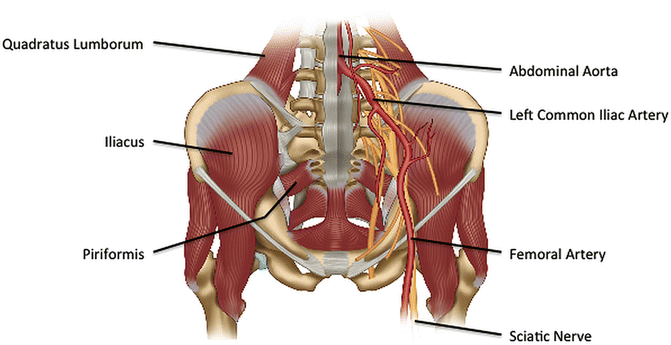Fig. 3.1
Transverse sections through the (a) anterosuperior, (b) middle, and (c) posteroinferior aspects of the sacroiliac joint. The arrows indicate the joint plane orientation of the right sacroiliac joint. Note the different orientations leading to a propeller-like shape of the sacroiliac joint [19]
Relative to the sagittal plane, the angle of the cephalad, middle, and caudal aspects of the joint varies greatly from 0 to 40° and can be oriented anterolateral-posteromedial or anteromedial-posterolateral [16, 19, 43]. The SIJ can be classified as a diarthrodial/synovial joint since it allows for motion and contains a synovial membrane, joint capsule, synovial fluid, cartilage on both articulating surfaces, and ligamentous connections.
The joint space is about 4.5 mm wide [10, 43] and the auricular surfaces are covered with cartilage on both the sacral and iliac sides. The sacral cartilage is from 1.1 to 3.0 mm thick, while the iliac cartilage is from 0.5 to 1.0 mm thick [10, 11, 55, 69] (Fig. 3.2).
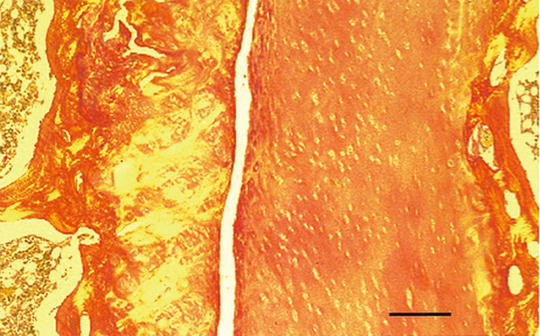

Fig. 3.2
Iliac cartilage (left) and sacral cartilage (right) separated by the sacroiliac joint space. Note the difference in cartilage thickness and collagen arrangement. Scale bar = 0.5 mm [55]
Where the cartilage integrates with the underlying bone, the bone end-plate thickness is inversely related to the cartilage thickness with the iliac side being thicker than the sacral side [55]. The thickness of the cartilage on both surfaces decreases with age with more fibrillations and deep fissures forming on the iliac surface [35, 63]. The sacral cartilage is creamy, white, and smooth and appears hyaline in nature, while the iliac cartilage is dull, bluish, and striated and appears more fibrocartilaginous in nature [11, 84]. Substance P and calcitonin gene-related peptide (CGRP) have been identified in the superficial layer of the sacral and iliac cartilage and may contribute to intra-articular nociception [76]. Ridges and corresponding depressions can be found throughout the sacral and iliac cartilage [41, 84]. Increased age is correlated with larger and more numerous ridges and depressions, with females having less pronounced characteristics [84, 90]. These ridges and depression potentially contribute to increased SIJ stability and increase the coefficient of friction at the joint surface.
Sacrum
The most cephalad aspect of the sacrum is the base (Fig. 3.3).
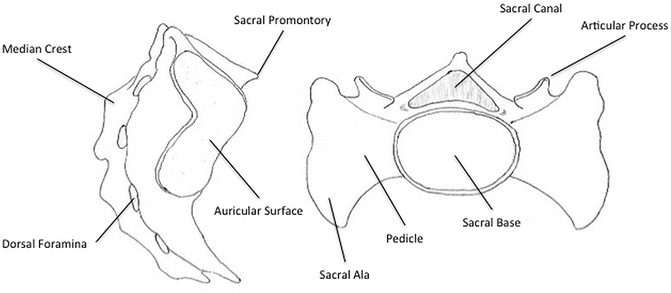

Fig. 3.3
Lateral and cephalad aspects of the sacrum
The base is broad and articulates with the fibrocartilaginous intervertebral disc between the fifth lumbar vertebra and the sacrum. The ventral aspect of the sacral base is the sacral promontory. In 18–30 % of the population, structural anomalies known as lumbosacral transitional vertebrae (LSTV) are found [13, 50, 60]. These LSTV can be classified based on whether the fifth lumbar vertebra is sacralized (characteristics of a sacral vertebra) or the first sacral vertebra is lumbarized (characteristics of a lumbar vertebra). Furthermore, these LSTV can be classified as Type I (dysplastic transverse process), Type II (accessory articulation), Type III (bony fusion), or Type IV (mixed) and either “a” (unilateral) or “b” (bilateral) [12]. The size and location of the auricular surfaces may also vary depending on the type of LSTV. A LSTV with a lumbarized S1 segment usually presents with a more cephalad SIJ with the auricular surfaces spanning from cephalad to the S1 vertebral body to the caudal aspect of the S2 vertebral body [51] (Fig. 3.4).
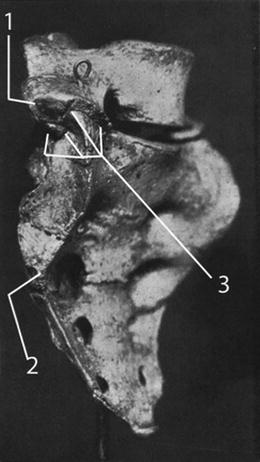

Fig. 3.4
A transitional lumbosacral vertebra and pseudojoint (3) within the auricular surface. Note the variable sacroiliac joint morphology with the superior aspect of the auricular surface (1) cephalad to S1 and the inferior aspect of the auricular surface (2) at the caudal aspect of S2. In a normal sacroiliac joint, the auricular surface spans from S1 to S3 [59]
Conversely, a LSTV with a sacralized L5 segment usually presents with a more caudal SIJ with the auricular surfaces spanning from the middle of the S1 vertebral body to the caudal aspect of the S3 vertebral body [51]. Therefore, with a unilateral LSTV, the SIJ on one side may be an entirely different size and be found in a slightly different location than that of the opposite side.
Lateral to the sacral base bilaterally are the pedicles with the most lateral aspect referred to as the sacral ala (Fig. 3.3). The S1 pedicle is about 2.6 cm wide (medial to lateral) and 2.5 cm deep (dorsal to ventral), while the S2 pedicle is about 2.0 cm wide and 1.8 cm deep [18, 22, 56]. The sacrum consists primarily of cancellous bone covered by a thin layer of cortical bone. The cancellous bone of the sacrum is denser ventrally [55]. At the S1 level, the sacrum is most dense at the ventral cortex of the sacral pedicle. The ventral cortex of the ala is second densest followed by the ventral cortex of the lateral aspect of the sacral vertebral body [67].
The sacrum is wedge shaped and typically composed of five sacral vertebrae. This wedge shape has evolved to support the body’s weight during bipedal gait [1]. Composing most of the sacrum, the sacral vertebral bodies and neural arches have fused to form one continuous bone. The first sacral vertebral body is about 2.8 cm high (cephalad to caudal), 4.3 cm wide (medial to lateral), and 2.3 cm deep (dorsal to ventral). The second and third sacral vertebral bodies are about 2.3 cm and 1.9 cm high, 3.0 cm and 2.3 cm wide, and 1.3 cm and 1.0 cm deep, respectively [46].
The sacral canal runs cephalad to caudal through the dorsal aspect of the sacrum and allows the passage of the sacral nerves (Fig. 3.3).
The caudal end of the sacral canal is often deficient and referred to as the sacral hiatus. The coccyx articulates with the caudal end of the sacrum and is composed of 3–5 vertebrae, the most caudal being fused together. This articulation where the sacrum meets the coccyx is a fibrocartilaginous joint and offers minimal movement. The cephalad aspect of the first coccygeal vertebra contains the coccygeal cornua, which articulates to the sacral cornua found on the lateral aspect of the sacral apex. Sacrococcygeal fusion is common in males and with increasing age and primarily involves the first coccygeal vertebra [77]. It is also correlated with LSTV [77].
The ventral aspect of the sacrum is concave and contains four sacral foramina allowing for the exit of the ventral rami of the first four sacral nerves (Fig. 3.5). The S1 ventral foramen can be found about 2.3 cm below the sacral base and 2.4 cm from the lateral border of the sacrum [26]. Four transverse ridges run horizontally between each foraminal level, indicating the site of osseous fusion of the sacral vertebral bodies.
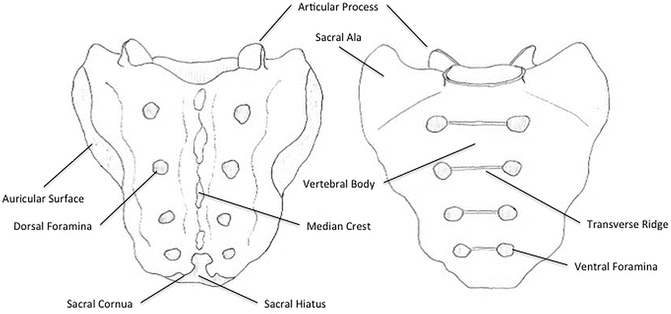

Fig. 3.5
Dorsal and ventral aspects of the sacrum
The dorsal aspect is convex and also contains four sacral foramina allowing for the exit of the dorsal rami of the first four sacral nerves (Fig. 3.5). The S1 dorsal foramen can be found about 2.3 cm below the sacral base and 3.7 cm from the lateral border of the sacrum [26]. Along the midline of the dorsal aspect of the sacrum is the median crest, which is composed of rudimentary spinous processes. The sacral groove is found on each side of the median crest.
Pelvis
The pelvis is made up of three bones bilaterally: the ilium, ischium, and pubis. The ala of the ilium forms the iliac crest. The iliac crest spans from the anterior superior iliac spine (ASIS) ventrally to the posterior superior iliac spine (PSIS) dorsally. The PSIS is approximately level with the second sacral vertebra in the coronal plane and is from 1.7 to 2.2 cm dorsal to the SIJ. The thickness of the ilium overlying the SIJ ranges from 0.8 to 2.2 cm medial to lateral and is generally thicker dorsally [15] (Fig. 3.6).
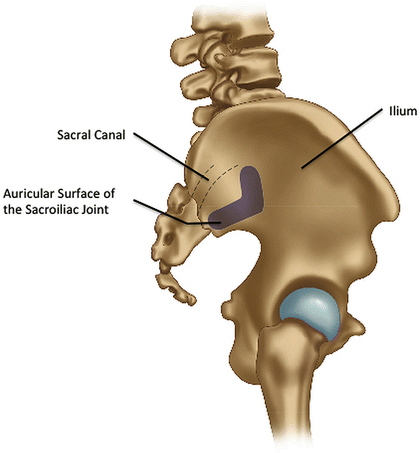

Fig. 3.6
Relationship of the auricular surface of the sacroiliac joint to the ilium (lateral view)
Just caudal to the PSIS is the posterior inferior iliac spine (PIIS), which forms the dorsal aspect of the greater sciatic notch. Here, the ilium is from 1.5 to 1.7 cm thick in the posterolateral to anteromedial direction [72]. The distance from the PSIS to the greater sciatic notch is about 4.0 cm [72].
The interior aspect of the ilium is smooth and concave and is referred to as the iliac fossa. The medial aspect of the iliac fossa articulates with the sacrum to form the SIJ. The arcuate line, or pelvic brim, extends caudal, ventral, and medially over the interior surface of the pelvis. It marks the inferior border of the greater or false pelvis. Below this line is the lesser or true pelvis.
The ischium is dorsal while the pubis is ventral. The most caudal aspect of the ischium is the ischial tuberosity. Located between the ischial spine and ischial tuberosity is the lesser sciatic notch. Both pubic bones meet ventrally and are joined together by fibrocartilage, which collectively is called the pubic symphysis. All three pelvic bones meet laterally to form a deep, cuplike structure called the acetabulum. The head of the femur articulates with the acetabulum to form the hip joint and is the point where the lower extremity transfers the ground reaction force to the pelvis.
Ligaments
Anterior Ligaments
The ventral sacroiliac ligament crosses the SIJ ventrally and caudally at the level of S1–S3 (Fig. 3.7).


Fig. 3.7
Ventral view of the ligaments and deep musculature
It blends with the ventral joint capsule and inserts on the periosteum close to the margins of the auricular surfaces of the sacrum and ilium [34, 63]. Mechanoreceptors and nociceptive fibers, including substance P and CGRP, have been identified within the ventral sacroiliac ligament and may contribute to the perception of pain from the SIJ [75]. The ventral sacroiliac ligament undergoes the most stress during forward flexion and axial rotation of the sacrum [24].
Posterior Ligaments
The sacrotuberous ligament has its origin at the PSIS, dorsal ligaments, sacral tubercles, sacrum, and superior coccyx [44] (Fig. 3.8).
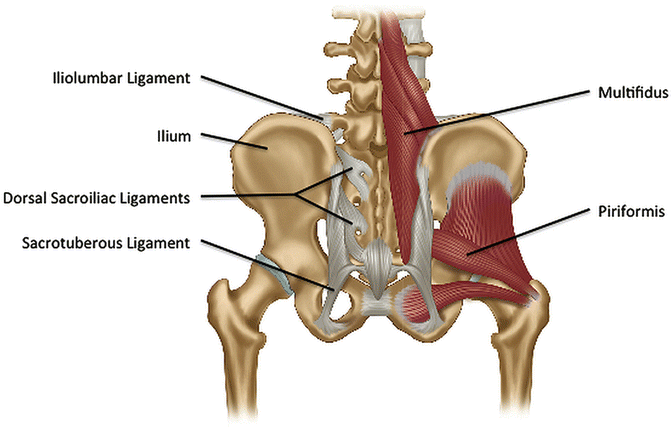

Fig. 3.8
Dorsal view of the ligaments and deep musculature
It has a spiral orientation and runs 6.5–12.2 cm to insert on the ischial tuberosity and, in some, the tendon of the long head of the biceps femoris [44, 80, 83, 85]. The medial fibers originate from the cephalad aspect of sacrum and lateral fibers originate from the caudal aspect of the sacrum [80]. The falciform process runs about 4.6 cm toward the ischioanal fossa and is found in about 87 % of the population [44]. It attaches at various locations including the ischial ramus, obturator fascia, and anococcygeal ligament [44]. The pudendal nerve and artery pass through Alcock’s canal formed by these structures. The fascia from the dorsal aspect of the piriformis is continuous with the sacrotuberous ligament and often has direct muscle fiber attachment to the ventral aspect of the ligament [83]. The gluteus maximus also has attachment to the sacrotuberous ligament. The sacrotuberous ligament resists forward flexion of the sacrum and can impose an extension force on the sacrum via its attachment to the gluteus maximus and long head of the biceps femoris.
Deep to the sacrotuberous ligament is the sacrospinous ligament. It extends from the lateral aspect of the apex of the sacrum and coccyx to the ischial spine. It is the division between the greater and lesser sciatic notches. The sciatic nerve and inferior gluteal artery run dorsal to the sacrospinous ligament, while the pudendal nerve runs ventral to it [40, 78]. The sacrospinous ligament resists forward flexion of the sacrum.
The dorsal sacroiliac ligaments, which are composed of the long and short ligaments, run from the PSIS to the S3–S5 sacral tubercles (Fig. 3.8). The lateral aspect is continuous with the gluteus maximus aponeurosis, while the medial aspect is continuous with the erector spinae aponeurosis and deep lamina of the posterior layer of the thoracolumbar fascia [53, 54, 81]. The lateral branches of the dorsal sacral rami (medial cluneal nerves) penetrate the dorsal ligaments and are surrounded by loose connective tissue within the ligament [53, 54]. Nociceptive fields [68] along with the presence of substance P [27] have been identified in the dorsal ligaments and may contribute to pain in the area of the SIJ. The dorsal ligaments demonstrate the most strain during extension of the sacrum [24].
Deep to the dorsal ligaments and located within the most cephalad aspect between the sacrum and ilium is the interosseous ligament. It consists of several short dense bands and often becomes ossified in people in and beyond their sixth decade of life [64]. The axial interosseous ligament is a component of the interosseous ligament and fills the space between the sacral cavity and iliac prominence just dorsal to the articular surface of the SIJ. It is composed of a mixture of collagen, blood vessels, and adipose tissue in comparison to other ligaments, which are largely composed of collagen [6]. Mechanoreceptors and nociceptive fibers (CGRP) have also been identified within this ligament and may contribute to joint proprioception and pain [75]. The interosseous ligament undergoes the highest strain during forward flexion of the sacrum and axial rotation [24].
Cephalad to the SIJ is the iliolumbar ligament. This ligament is composed of a dorsal band, ventral band, and sacroiliac part. The dorsal band originates at the tip of the L5 transverse process and inserts onto the ventral and cephalad aspect of the iliac tuberosity and crest [62, 65]. It also has direct attachment to the deep layer of the thoracolumbar fascia, erector spinae aponeurosis, and quadratus lumborum [31, 62]. The ventral band originates at the anteroinferior aspect of the L5 transverse process and caudal aspect of the L5 end plate and fans out to insert on the anterosuperior aspect of the iliac tuberosity 2.0–3.0 mm below the dorsal band insertion [62, 65]. The medial iliacus has some connections with the caudal part of the ventral band. The sacroiliac part runs from the cephalad surface of the sacral ala and joins the ventral band at the iliac tuberosity [62] (Fig. 3.7). It also merges with the L5–S1 intertransverse ligament and interosseous ligament [62]. Receptors identified within the iliolumbar ligament include proprioceptive organs and free-nerve endings. The highest concentration of these receptors is found within the ligament at its iliac insertion [39]. The iliolumbar ligament primarily resists forward flexion at L5–S1 (dorsal band) and side bending (ventral band) and becomes more important biomechanically as the intervertebral disc degenerates and loses height [42]. The iliolumbar ligament is protected by activation of the erector spinae muscles [73] (Table 3.1).
Table 3.1
Ligaments and associated contributions to the sacroiliac joint
Ligament | Location | Primary restraint | Nerve fibers |
|---|---|---|---|
Dorsal ligaments Long ligament Short ligament | PSIS to sacral tubercles | Sacral extension | Nociceptors Substance P Penetrated by middle cluneal nerves |
Sacrotuberous | PSIS and sacrum to ischial tuberosity | Sacral flexion | – |
Sacrospinous | Apex of sacrum to ischial spine | Sacral flexion | – |
Ventral ligament | Crosses ventral and caudal aspect of SIJ | Sacral flexion Axial rotation | Mechanoreceptors Nociceptors CGRP, substance P |
Interosseous | Between sacrum and ilium dorsal to SIJ | Sacral flexion Axial rotation | Mechanoreceptors Nociceptors CGRP |
Iliolumbar Ventral band Dorsal band Sacroiliac part | Transverse process of L5 to iliac tuberosity and crest | Lateral side bending Ventral band Forward flexion Dorsal band | Mechanoreceptors Nociceptors |
Muscles
Anterior Muscles
Several muscles compose the abdominal wall. These muscles include (superficial to deep) the rectus abdominis, external oblique, internal oblique, transversus abdominis, and quadratus lumborum. The rectus abdominis has its origin on the pubic crest and ligaments of the pubic symphysis. It runs cephalad and inserts onto the xiphoid process and fifth to seventh ribs. It is innervated by the lower intercostal nerves and contributes to forward flexion of the trunk. Deep to the rectus abdominis, the external oblique has its origin on the lower six ribs and inserts inferomedially onto the anterior aspect of the iliac crest, pubis, and aponeurosis of the linea alba. It receives its innervation from many nerves including the lower intercostal, iliohypogastric, and ilioinguinal nerves. It acts to compress the abdominal cavity and assists with forward flexion and rotation of the trunk.
The internal oblique has its origin over the iliopsoas fascia, inguinal ligament, and iliac crest and has variable attachment to the thoracolumbar fascia. Its fibers run superolaterally and insert onto the lower ribs and aponeurosis of the linea alba. Its innervation and primary actions are similar to the external oblique. However, in contrast to the external oblique, rotation will be in the opposite direction. The transversus abdominis has its origin at the middle layer of the thoracolumbar fascia, iliac crest, iliopsoas fascia, and inguinal ligament. It inserts onto the aponeurosis of the linea alba and is innervated by the same nerves as the internal and external oblique muscles. The primary action of the transversus abdominis is compression of the abdominal cavity. It also plays an important role in force closure of the SIJ via its attachment to the thoracolumbar fascia (Fig. 3.9).


Fig. 3.9
The relationship of the thoracolumbar fascia and surrounding musculature. EO external oblique, Il iliocostalis lumborum, IO internal oblique, LD latissimus dorsi, LIFT lumbar interfascial triangle, Lo longissimus thoracis, MLF middle layer of the thoracolumbar fascia, Mu multifidus, QL quadratus lumborum, SPI serratus posterior inferior, sPLF superficial lamina of the posterior layer of the thoracolumbar fascia, TF transversalis fascia, TrA transversus abdominis. 1 = investing fascia of QL, 2 = aponeurosis of the abdominal muscles deriving from TrA, 3 = paraspinal retinacular sheath (PRS), 4 = aponeurosis of the paraspinal muscles, 5 = portion of the PRS composed of the deep lamina of the posterior layer of the thoracolumbar fascia, 6 = investing fascia of SPI, 7 = aponeurosis of SPI, 8 = investing fascia of LD, 9 = aponeurosis of LD [92]
The quadratus lumborum is deep to the transversus abdominis and has its origin over the medial aspect of the iliac crest. It inserts onto the twelfth rib and lower lumbar vertebrae and is innervated by the nerves of T12–L3. The primary action of the quadratus lumborum is lateral flexion of the vertebral column and fixation of the distal ribs to allow for proper contraction of the diaphragm.
The iliopsoas muscle group is composed of two muscles, the psoas major and iliacus. The psoas major has its origin on the bodies and transverse processes of the lumbar vertebrae and runs anteroinferiorly to insert on the lesser trochanter of the femur (Fig. 3.7). It is innervated by the second to fourth lumbar nerves and contributes to hip flexion (open chain) and lumbar flexion (closed chain). The iliacus has its origin over the iliac fossa, ventral sacroiliac ligament, iliolumbar ligament, and base of the sacrum and runs anteroinferiorly to insert on the lesser trochanter of the femur along with the psoas major. The iliacus is innervated by the femoral nerve and aids in hip flexion (open chain) and tilts the pelvis and sacrum ventrally (closed chain). Another muscle in close relation to the iliopsoas group is the psoas minor. The psoas minor is cephalad and ventral to the psoas major and has its origin at the twelfth thoracic and first lumbar vertebrae. It inserts on the superior ramus of the pubis and has the primary action of upward rotation of the pelvis.
The pelvic floor is composed of the levator ani, ischiococcygeus, iliococcygeus, and pubococcygeus. They form a sling through the pelvic ring and make up the floor of the abdominal cavity. The muscles of the pelvic floor activate up to 500 ms prior to any increases in intra-abdominal pressure and help support the pelvic viscera [33, 71]. They are also involved with respiration [33]. Contraction of these muscles can increase the stability of the pelvic ring and stiffness at the SIJ while also causing extension of the sacrum [61].
Posterior Muscles
The gluteus maximus has its origins, arcing from superolateral to inferomedial, at the gluteus medius fascia, ilium, thoracolumbar fascia, erector spinae aponeurosis, dorsal sacroiliac ligaments, sacrum, sacrotuberous ligament, and coccyx. The fascicle orientation runs inferolaterally at 32–45°, and two-thirds inserts onto the iliotibial band at its aponeurotic origin over the greater trochanter and the other one-third inserts onto the gluteal tuberosity [5]. The gluteus maximus attachment to the superficial lamina of the posterior layer of the thoracolumbar fascia is between the lower border of the PSIS and a point 1.0–2.0 cm lateral to the S3 spinous process [5], which then projects across the midline between L3 and S3. These fibers turn into the origin of the transitional component of the latissimus dorsi at L1–L2 and supraspinous ligament. The latissimus dorsi has five other components and origins at the lateral raphe of the thoracolumbar fascia and L3–L5 (raphe component), iliac crest 2.0–5.0 cm lateral to the lateral border of the erector spinae (iliac component), lower three ribs (costal component), lower six thoracic vertebrae and supraspinous ligaments (thoracic component), and inferior angle of scapula (scapular component) [9]. The latissimus dorsi inserts on the intertubercular sulcus of the humerus. In regard to innervation, the gluteus maximus and latissimus dorsi are innervated by the inferior gluteal nerve and thoracolumbar nerve, respectively. These two muscles have a reciprocal relationship during walking and have the ability to add stability to the SIJ, primarily from the action of the gluteus maximus whose fibers are oriented almost perpendicular to the SIJ [5, 9].
The posterior layer of the thoracolumbar fascia also consists of a deep lamina. The fibers of the deep lamina have their origin at the spinous processes of the lumbar vertebrae and run superomedial to inferolateral (30–40°) in contrast to the superficial lamina fibers, which run superolateral to inferomedial [8, 48, 82]. This opposition in fiber orientation gives the posterior layer of the thoracolumbar fascia a crosshatched appearance. The deep lamina has attachments with the sacrotuberous ligament, PSIS, iliac crest, and long dorsal ligament [82]. The deep lamina fuses with the serratus posterior inferior in the thoracic region. These two layers form a retinaculum over the epaxial muscles and are fused at the sacral levels (Fig. 3.9).
The erector spinae, which are a component of the epaxial muscles, consist of both the iliocostalis lumborum and longissimus thoracis. Both muscles have thoracic and lumbar components. The thoracic component of the iliocostalis lumborum runs from the lower ribs to the dorsal PSIS and iliac crest and the lumbar component runs from the tip of the lumbar transverse processes to the ventral iliac crest [47]. The thoracic component of the longissimus thoracis runs from the thoracic transverse processes and ribs to the lumbar and sacral spinous processes, dorsal aspect of the 4th sacral segment, and interspinous region of the posterior ilium. Its lumbar component runs from the lumbar transverse processes and accessory processes to the ventral aspect of the PSIS and iliac crest [47]. The thoracic fibers of the iliocostalis lumborum and longissimus thoracis form the erector spinae aponeurosis, which is freely mobile over the lumbar fibers [47]. The lumbar intermuscular aponeurosis, formed by the caudal tendons of the lumbar component of longissimus thoracis, separates the lumbar components of the iliocostalis lumborum and longissimus thoracis [47]. A cleavage plane separates the erector spinae from the multifidus. This cleavage plane runs from the medial aspect of the PSIS toward the L1 vertebra, curving cranial 2.0 cm lateral to the spinous process [47]. The multifidus originates at the lumbar spinous processes and laminae and inserts at the mammillary processes, inferomedial aspect of the PSIS, erector spinae aponeurosis, dorsal aspect of the sacrum to S4, and dorsal sacroiliac ligaments [49] (Fig. 3.8). It receives its innervation from the medial branch of the dorsal rami of the same segmental number.
The middle layer of the thoracolumbar fascia originates from the tips of the lumbar transverse processes and intertransverse ligaments to the border of the transversus abdominis where it blends with the posterior layer of the thoracolumbar fascia [8] (Fig. 3.9). This attachment lies lateral to the lateral border of the erector spinae and forms a dense lateral raphe. The posterior layer and middle layer of the thoracolumbar fascia form the paraspinal retinacular sheath around the epaxial muscles [71] (Fig. 3.9). Arising from the middle layer of the thoracolumbar fascia between the 12th rib and iliac crest is the transversus abdominis. The internal oblique has variable attachment to the thoracolumbar fascia but primarily arises from the iliac crest. Contraction of the deep abdominal muscles, primarily the transversus abdominis, provides lateral tension on the lateral raphe, which exerts a small extension force on the lumbar spine [48]. Lateral tension on the lateral raphe via the deep abdominal muscles combined with contraction of the epaxial muscles puts tension through the posterior and middle layers of the thoracolumbar fascia which compose the PRS. This tension and pressure can assist with lumbar extension from a flexed position via the hydraulic amplifier mechanism [8, 30, 71].
Ventral to the middle layer of the thoracolumbar fascia is the deep layer of the thoracolumbar fascia and dorsal border of the quadratus lumborum (Fig. 3.9). Ventral to the erector spinae and multifidus are the rotatores. The rotatores muscles have their origin at the sacrum and transverse processes of the vertebrae (lumbar to cervical). They insert on the spinous process of the vertebra one to two segments cephalad.
Lateral and ventral to the gluteus maximus is the gluteus medius. The gluteus medius has its origin over the lateral surface of the ilium between the anterior and posterior gluteal lines (Fig. 3.10).


Fig. 3.10
Lateral view of the superficial musculature and neurovascular structures
It inserts onto the greater trochanter of the femur and is innervated by the superior gluteal nerve. Deep to the gluteus medius is the gluteus minimus. The gluteus medius and minimus are the primary hip abductors and play an important role in stabilizing the pelvis in the frontal plane during single-leg stance.
The piriformis muscle has its origin on the ventral surface of the sacrum (Fig. 3.11).

